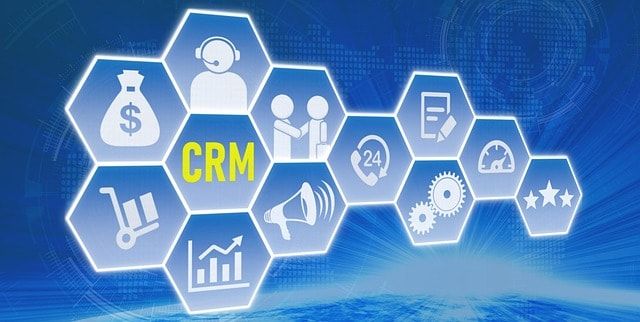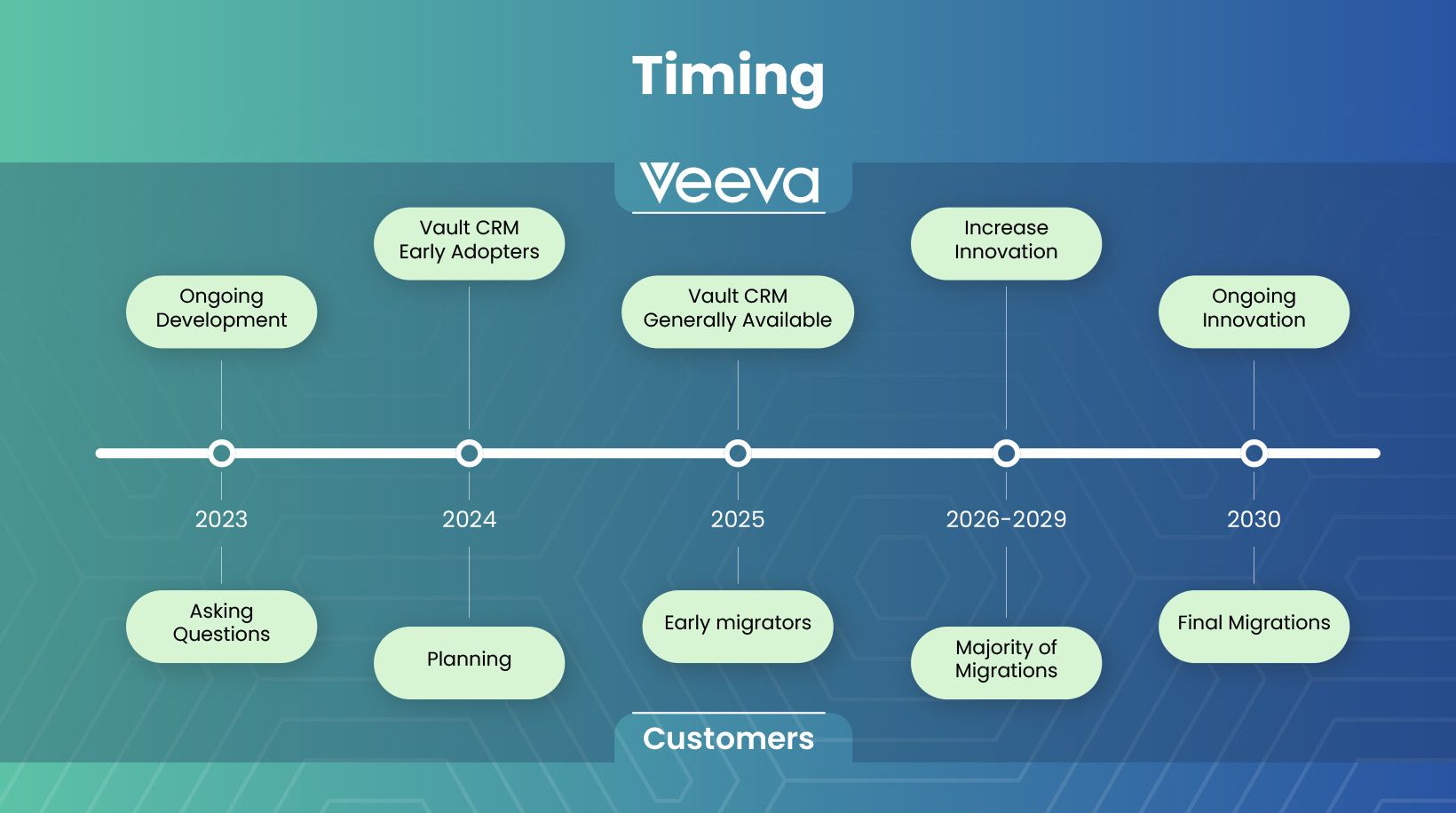With Veeva and Salesforce as global front runners in life science customer relationship management (CRM) and commercial tech landscape, it was a natural partnership from the start. But that marriage is soon to end as Veeva announced it will not be renewing their agreement to remain on the Salesforce platform once it expires in September 2025. Instead, it will be moving its CRM to the new Veeva Vault CRM, their own system specifically made for Life Science organizations.
So, what does this mean for Veeva? What does this mean for its users? And how can marketers in the Pharma world prepare for the big switch? Assemble has been doing our due diligence to get all those answers. Here’s everything you need to know.
Introduction to Veeva CRM
Veeva CRM is a customer relationship management solution meticulously crafted for the life sciences industry. Initially built on the Salesforce platform, it has been a cornerstone for pharmaceutical and biotech companies, aiding them in managing customer relationships, clinical operations, and regulatory compliances.
With its robust features and scalability, Veeva CRM has become indispensable for life sciences companies, streamlining operations and enhancing patient outcomes. Its integration with Salesforce allowed it to leverage the platform's powerful cloud-based capabilities, making it a leading solution in the industry.
The Partnership and Transition from the Salesforce Platform
Since 2007, Veeva and Salesforce have enjoyed a fruitful partnership, with Veeva CRM leveraging the capabilities and credibility of the Salesforce brand to deliver exceptional service to the life sciences sector. However, in a strategic move announced back in late 2022, Veeva declared that it will transition its CRM solution to its own bespoke technology, Veeva Vault CRM.
The decision to transition away from Salesforce marks a significant milestone in Veeva's journey towards self-reliance and innovation—driven by a goal to achieve self-resilience in cloud-based data management and reduce the platform's reliance on a third-party infrastructure. With the CRM's launch in April 2024, it marks a significant shift in how Veeva delivers its services, giving users the ability to manage content and data on a singular platform with architecture intentionally designed for the nuanced world of life sciences.

Why the Breakup between Veeva and Salesforce?
While the partnership had its benefits for both platforms, it wasn’t all roses at the beginning. In fact, Veeva always had its concerns with dependence on a third party infrastructure, which facilitated Veeva's CRM capabilities within the pharmaceutical sector. Many of these concerns started coming true. The risks being:
- Less than optimal customer experience. The pair suffered significant service outages in the past.
- Geography/Market restrictions. The markets in which Veeva could sell its CRM were highly dependent on Salesforce, meaning it would also be left stranded if they left any existing markets.
- Domain expansion restrictions. As the leader in the MedTech domain, Salesforce restricted Veeva from expanding here.
- Competitor product possibility. The agreement doesn’t restrict Salesforce’s customers from being able to customize or configure their platform to meet their operational needs — versus buying Veeva products.
- High exit cost. The cost to shift Veeva CRM to another platform is astronomical. And if Salesforce annulled the agreement on short notice, it would massively impact all Veeva users.
What is Veeva’s Next Move?
By developing their own CRM, Veeva aims to create a more seamless and integrated experience for its users, focusing on the specific needs and challenges of pharmaceutical marketing. This move not only empowers Veeva to have greater control over its technological infrastructure but also opens doors to new possibilities in the realm of customer relationship management.
They planned to create an entire ecosystem of connected applications, datasets and processes that keeps the information client information, metrics, tracking, past and expected behavior, etc. to make all of these things as effective and purposeful as possible. Catering specifically to the pharmaceutical industry, Vault CRM enhances HCPs and providers ability to manage client information and metrics with ease.
On top of that, they also made all backend implementations a lot faster and more straightforward than it was with the Salesforce platform. How much faster? Well, let's just say there are still specific feature requests from clients made in 2009 still pending…
Veeva Vault CRM: The New Technology
Veeva Vault CRM represents the next generation of customer relationship management solutions, built on the innovative Veeva Vault platform. This cloud-based CRM solution is designed to provide a unified customer database, integrating their Vault CLM (Closed Loop Marketing) web technologies, Approved Emails, AI Partner Program, and more to facilitate customer-centric engagement and supporting complex therapies and personalized HCP journeys.
Utilizing Java and open-source technologies, along with web services from Amazon, Veeva's new CRM is hosted at SOC 1 Type II and ISO 27001-certified global data centers. The platform promises simpler functionality and easier access to information, with features such as assigned accounts, calendar, territory or region management, and custom reports, all tailored to meet the specific needs of the life sciences industry.
Benefits of Veeva Vault CRM
The transition to Veeva's new CRM is poised to bring numerous benefits to Veeva's exisiting customers. One of the most significant advantages is the enhancement of customer experiences, with all new solutions and applications hosted in a single, unified source. This integration will streamline operations and improve service delivery.
Additionally, the end of Salesforce restrictions opens up new growth opportunities, allowing Veeva to expand into the MedTech-focused CRM market more rapidly. The Vault CRM app, already live and connected to the Vault CRM platform, includes a ChatGPT-like add-on, providing reps with key insights on how to conduct calls with HCPs. Designed to support customer-centric engagement and personalized HCP journeys, Veeva Vault CRM offers a unified data model and advanced capabilities, ensuring that Veeva customers can achieve their operational goals more efficiently.

What the HCP Experience Now Looks Like
For those of us who have experienced the Salesforce interface, we can probably all agree on how complicated it can be to just find information or account details at times, let alone building a metrics report. It’s a huge, multi-purpose system — we get it. But Veeva implemented much simpler functionality, that includes everything necessary for a Life Sciences specific CRM. Accessing your assigned accounts, calendar, territory or region, and custom reports are all much easier and streamlined.
While Salesforce's Health Cloud has been leveraged in the past to cater to pharmaceuticals and biotech companies, providing comprehensive CRM solutions within the healthcare space, Vault CRM aims to provide similar comprehensive CRM solutions tailored for the medical device and pharmaceutical sectors.
The Veeva CRM Timeline

What it Means for Users
Better Customer Experiences. With all new solutions and applications hosted in a single source, the end-to-end customer experience will be superior. It will also leverage its strong partner ecosystem across therapeutic areas and functions to facilitate first-hand and personalized service from Veeva support. Salesforce's Media Cloud, along with other specialized clouds, has been used to create tailored solutions for the pharmaceutical industry.
Growth. With the end of Salesforce restrictions, Veeva will most certainly break into a MedTech-focused CRM as well, with more rapid growth than other domains. This will only be in addition to continuing its expansion in the Pharma market.
Vault CRM App. As of April 11th, 2024, the Vault CRM app is live. The only difference to the existing app is that it’s connected to Salesforce CRM, while the new app is already connected to Vault CRM platform. Once the transition is complete, this will be the only CRM part of the Veeva system.
Veeva CRM Bot. The new Vault CRM app also comes with a ChatGPT like add-on as part of an additional license, allowing reps to get key insights on how to conduct calls with HCPs (an extra license will be required).
Challenges during the Transition
CRM is the only part of the Veeva ecosystem that relies on Salesforce — making up just 5%. So replacing this minor segment should be pretty easy and painless. With Veeva’s backend layer keeping track of all customer and HCP information (i.e., purchase history, specialties, location, etc.), it will conduct an “under the shell” process of migration, with the Vault CRM mirroring what is done on Salesforce CRM during the platforms’ overlap. This will give users time to digest the new Vault CRM interface and its custom implementations as compared to existing features in Salesforce CRM.
In addition, Salesforce already has specialized clouds, such as Health Cloud and Energy & Utilities Cloud, that they leverage to build tailored solutions for the pharmaceutical sector, particularly in light of Veeva's transition away from Salesforce. So their branching out won't come without some competition.
But the industry will continue to watch closely to see how the two companies will evolve and adapt to the changing landscape of life sciences CRM. With Veeva's focus on innovation and customer-centric solutions, the future holds exciting prospects for both Veeva and its users. Only time will tell.
How to Migrate Existing Data to Veeva Vault Platform
Don't worry — making the transition doesn't actually require much manual effort— for the most part. There's nothing Veeva users actually have to do on their part. Everything already in Salesforce will be duplicated into Vault CRM, and the migration will happen systematically. And any information added during the transition period will be stored in both areas.
What Should You Worry About?
If you're part of the 62% of users who applied significant customizations to your Salesforce environments through proprietary tools (such as APEX, lightning components, etc.), they'll need to be migrated to the primary language technologies used to build this new Vault CRM layer (i.e., JAVA). This could take up to a couple of weeks or months, depending on the architecture of these implementations.
But as part of the effort to make the migration more seamless, Veeva will provide inventories of those existing customizations, displaying what those items are, which are actually in use, and which are no longer relevant.
Good news for the other 38% of users who have implemented very minimal customizations, the impact of the transition is going to be very minimal.
Assemble is Here to Help the Pharmaceutical Industry
By mapping out your transition journey today, your team can be fully prepared to take advantage of the changes to come right from the get-go. And if you have questions, let the Assemble team help.
We pride ourselves on being Veeva Marketing experts, so we're staying on top of all the latest regarding the big move and how you can get the most out of the CRM moving forward. We're also certified in IQVIA, so if you're looking to learn more about the benefits of IQVIA v. Veeva, we can help there too. Just contact us to chat about your goals today.

